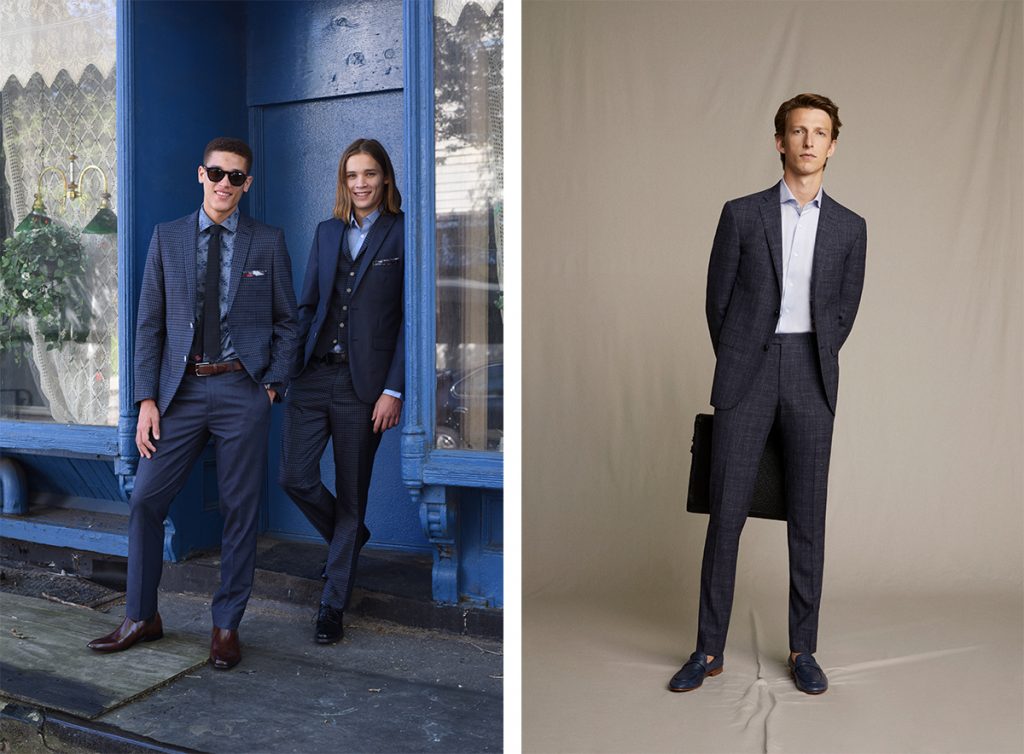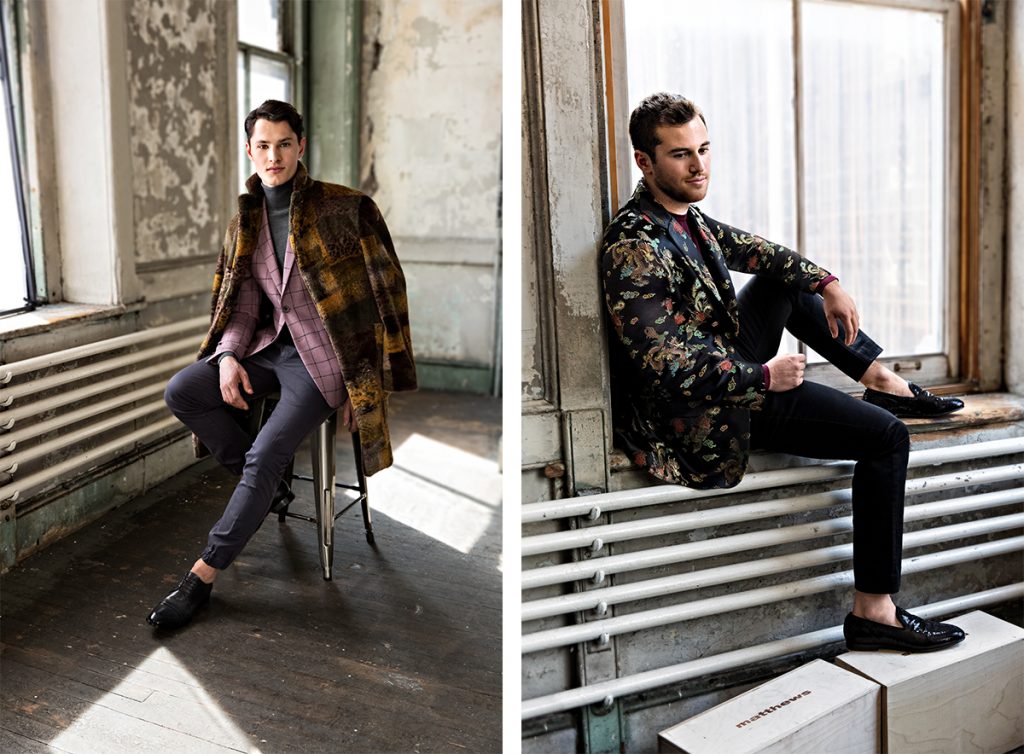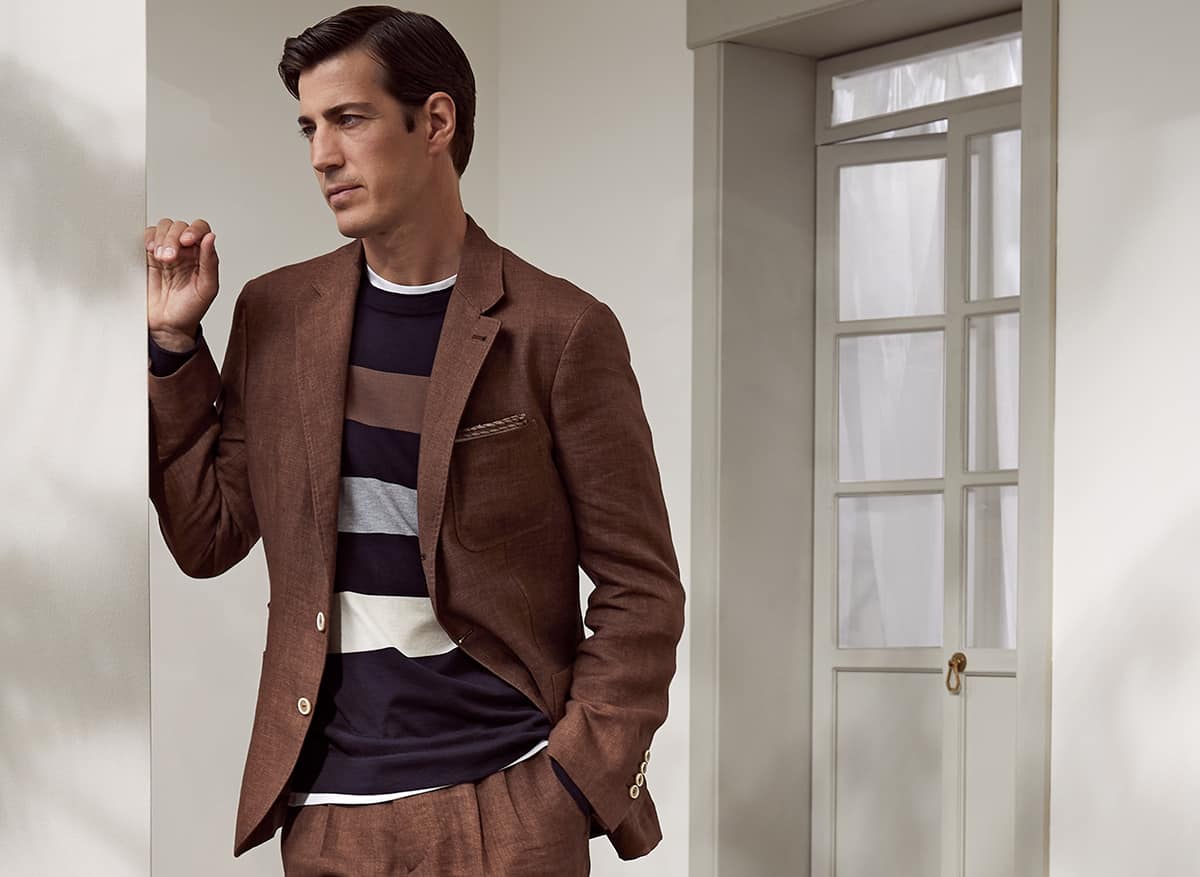TAILORED IN TRANSITION

Despite much recent innovation in tailored clothing (new comfort and performance fabrics, speed to market, flexible sourcing, customization, technology to enhance both the design process and the shopping experience), tailored clothing is still a shrinking business. With wool prices up, dress codes still casual and no compelling new fashion direction (other than some exaggerated styles on the runways), maintaining unit sales is a challenge.
That said, merchants and manufacturers focusing on niche businesses (occasion dressing, made-to-measure, performance fabrics) are reporting notable gains.
In fact, performance fabrics are in particular demand of late due to the rising price of wool. Says Ben Onorato of honoursourcing.com, a Brand Advancement Specialist, “Since reaching a record high in September ’18, wool prices have dropped somewhat, but they’re still too high for the market to absorb or predict. It’s time for retailers and manufacturers to fully embrace blended, innovative textiles that are engineered for performance and comfort and better cater to today’s modern consumer. Doing so could result in a 20-30 percent cost savings, enabling companies to maintain or even elevate their margins.”
Explains Mickey Solomon of HMS International/Gladson Ltd., one of the largest purveyors of men’s fabrics in the U.S., “It’s tough to assess what will happen. The last round was a double whammy: Increased prices from Australia (the only source for merino) plus the weakness of the dollar meant wool prices went up 20-25 percent in a year! Still, our industry has blinders on: We don’t appreciate what a bargain wool is. After around 1970, all worsted fabric (tropical or twill) was a set price until about two years ago. Today, 50 years later, it’s only 10 percent higher. We’re the quintessential example of deflation.”
(Editor’s note: According to Solomon, in today’s totally free market, prices are elastic. The Chinese have been the biggest buyers for 20 years, consuming 75 percent of the world’s production of wool. Consumption by Italian mill owners, by comparison, is tiny.)

While volume-priced retailers and brands are increasing their penetration of blended fabrics, luxury merchants are hesitant, with customers accustomed to pure wool. “The increased cost of wool is scary!” admits Jeff Farbstein at Harry Rosen. “It’s a big fight lately with our vendors—merino and cashmere prices are ridiculous! With China monopolizing the market, there’s not much to be done about it, but price increases are definitely impacting sales.” Farbstein confides that even made-to-measure, the fastest growing segment of his clothing business, has somewhat slowed, with flat sales this fall/winter compared to six to seven percent increases this past spring. That said, he’s had considerable success with his new Zegna shops and, at the other end of the spectrum, opening price made-to-measure from Amsterdam-based Munro, giving Millennials their first taste of customization.
Also successful with his foray into entry-level made-to-measure, Scott Shapiro from Syd Jerome Chicago sells Munro made-to-measure suits at about $1,000 (two for $1,995) while still doing most of his business in luxury brands. (His average suit ticket is $2,400; clients spend up to $6,000 for Brioni.) “What drives our clothing business is luxury, inventory and slimmer models. Our guys are noticing their suits look dated—coats too long, pants too baggy—so they’re shopping for something slimmer. We’ve found that younger guys like custom, which is why we brought in Munro. Sometimes it’s about fit: We’ve got workout guys with a 44 chest, 30-inch waist and big biceps (which, if they buy off the rack, ends up costing me $400 worth of tailoring that I can’t charge them for…). But often, the appeal of made-to-measure with young guys is not the fit but the touchscreen, allowing customers to personalize lapels, buttons, linings and more. Munro offers half-canvas, full-canvas and bespoke, made in China or Italy. They’ve done a good job!”
According to Justin MacInerney at Gladson, growth in made-to-measure is also driven by limited model selection in off-the-rack offerings. “If you want DB models, three-piece suits or formalwear, you won’t easily find it off-the-rack. That’s why we’re undertaking a crusade to educate consumers to try something different. Even Men’s Wearhouse consumers are showing a growing appetite for customization.”
Indeed. Men’s Wearhouse now offers made-to-measure in both their Joseph Abboud label ($895 and up for Abboud’s canvas make, U.S. production, Italian piece goods; $395 and up for JOE, now with a one-week delivery option) and more recently in their Kenneth Cole Awearness brand, crafted in their exclusive temperature-regulating fabric ($795 retail and up with a contribution to war veterans with every suit purchase). According to Tailored Brands, MTM is clearly the fastest-growing component of their business, with a good 20 percent geared to wedding parties. Remarkably, almost a third of Men’s Wearhouse’s customer base is now Millennials.
BOLD MOVES FOR MANUFACTURERS

At the wholesale level, clothing makers are doing what they can to jumpstart sales and compete with a growing number of direct sellers, both online and in homes and offices. Says Michael Parker from Lanier, “We all know at the macro level that men’s tailored clothing is contracting. However, we’re experiencing strong retail selling over last year by bringing in great brands at a great value.” At Paisley & Gray, Vince Marrone says formalwear and fashion separates remain top sellers; going forward, they’re adding premium wool and limited edition product to the roster. “What’s needed is fun and excitement; our mission is to create the unexpected.”
Notes John Tighe at Peerless, “Guys want more performance in their clothing: stretch, antimicrobial, stain-resistance. So we’re using blends and/or natural stretch fibers in every tier of the business even better. Other recent initiatives include expanding our brand portfolio (Hilfiger, Robert Graham), the full takeover and update of Hart Schaffner Marx, and the expansion of Tallia and TailoRed. We’re also growing our replenishment programs, offering state-of-the-art analytics and increased capacity in our Vermont warehouse. Peerless has always excelled in sourcing: As the world continues to change—tariffs, wage increases, raw material prices—we’ve become very nimble and disciplined in our product development and production.”
David Schuster, VP at Paul Betenly, details recent changes that include: ramping up in-stock offerings, adding more casual, garment-washed items, adding salespeople to the team and introducing full lifestyle collections for their Weekender and Traveler series. “By increasing our in-stock position,” says Schuster, “we can grow our customer base. Specialty store merchants today want to partner with their vendors; our investment in in-stock fashion reflects our commitment to these partnerships.”
Also a believer in partnerships, Geoff Schneiderman says Eleventy is working with their upscale specialty store accounts to open modern Eleventy shop-in-shops or, in some cases, adjacent stores. “We’ve done four so far, and plan 10 to 20 more in the next two years.” The company is maintaining its focus on sportcoats (about 40 percent of the mix); their best-selling suede-trim knit sportcoat still retails for $595, a ticket that hasn’t changed in the three years they’ve been in business. The brand is also reconfiguring its sizing for U.S. customers. Admits Schneiderman, “We go up to a size 50 jacket and a 40 waist pant but these sizes are rarely in stock; we’re working to fix that!”

At Corneliani, style director Stefano Gaudioso Tramonte is honest about current challenges. “I think brands will become increasingly powerless in terms of influencing the way people dress, and tailored clothing is for sure the most difficult category to revitalize. For the FW19 collection, we’ve worked to lighten our garments using exclusive fabrics. We’re focused on street-tailoring, using different fabric technologies for performance and comfort. Our main missions are ‘service’ and ‘experience.’ Our new digital platform and sales training programs were launched last year, our new store concept was presented in Rome in July, and new partnerships will create the ultimate retail experience in key markets.”
Arnold Silverstone, creative director for Samuelsohn and Hickey Freeman, speaks to the many ways his brands are evolving: more focus on custom (including this year’s launch of SID, Samuelsohn’s interactive design technology); more categories and diverse product offerings; a stronger focus on digital (including marketing, design, and storytelling to communicate sustainability, social causes and corporate responsibility); better flexibility in operations for faster turn and service; and much research into new technologies in everything from customer touch points to fabrics to production. “We want to differentiate ourselves as the leader in value-priced luxury clothing,” he concludes.
But are any of these moves enough to inspire purchasing by customers who no longer wear suits that often? Sums up Tramonte at Corneliani: “Tailored clothing will not disappear; it’s just a matter of how it will evolve and how good we’ll be at attracting a new consumer. What’s needed: new fabrics (like jersey and technical), comfortable shapes, and lots of storytelling to communicate that wearing a suit is COOL!”
Although most U.S. retailers are still fully invested in the slim suit models they’ve been selling for the past several years, designer Joseph Abboud suggests it’s time to aggressively promote something new. “Suits can’t get any shorter or skinnier!” he observes. “To me, the shrunken suit looks dated; it’s been post-peak for a while now and guys popping out of their suits look silly and uncomfortable. I believe in pleats, in a little more fullness and flow but still following a man’s body shape (and always in classic menswear fabrics). In other words, suits should be fluid but not the exaggerated gender-fluid styles certain fashion runways are promoting. I worry that these runway designers are losing some brain cells; I don’t think too many men are clamoring to dress like women.”




rovitosfinemensclothing.com
I agree with Mr Abboud……the trim fit look is now played out; It has been over a decade that Thom Browne started it with that “emaciated” look, which I always thought looked silly. However, it will take some time before the fuller cut comes back; Tom Ford’s big shoulders won’t happen everywhere right away. And in recognizing the article mentions higher wool prices, fuller cuts mean more fabric used, and therefore, higher prices.
I note a lack of variety in fabrics. There is little to buy other than varieties of black.
An important viewpoint in addressing today’s tailored buying customer is that Tailored has become an accessory rather than the main item in a man’s wardrobe. It’s not that tailored has been eliminated in today’s wardrobe for men, but has become a smaller part in whole to a total lifestyle approach in dressing.
That’s why in our lines, we address specific items and occasion driven tailored items that not only are performance driven but lifestyle driven. Pieces that have an actual place in the lifestyles of the young men today. Evening attire, performance driven career wear, and easy impeccably tailored soft sweater jackets.
The last part of this challenge is to tell the story to the young man. And you have to go where the fish are. Online. Digital marketing with Inspirational story telling and roots in authenticism which show your brand is key to your customers lifestyle and values.